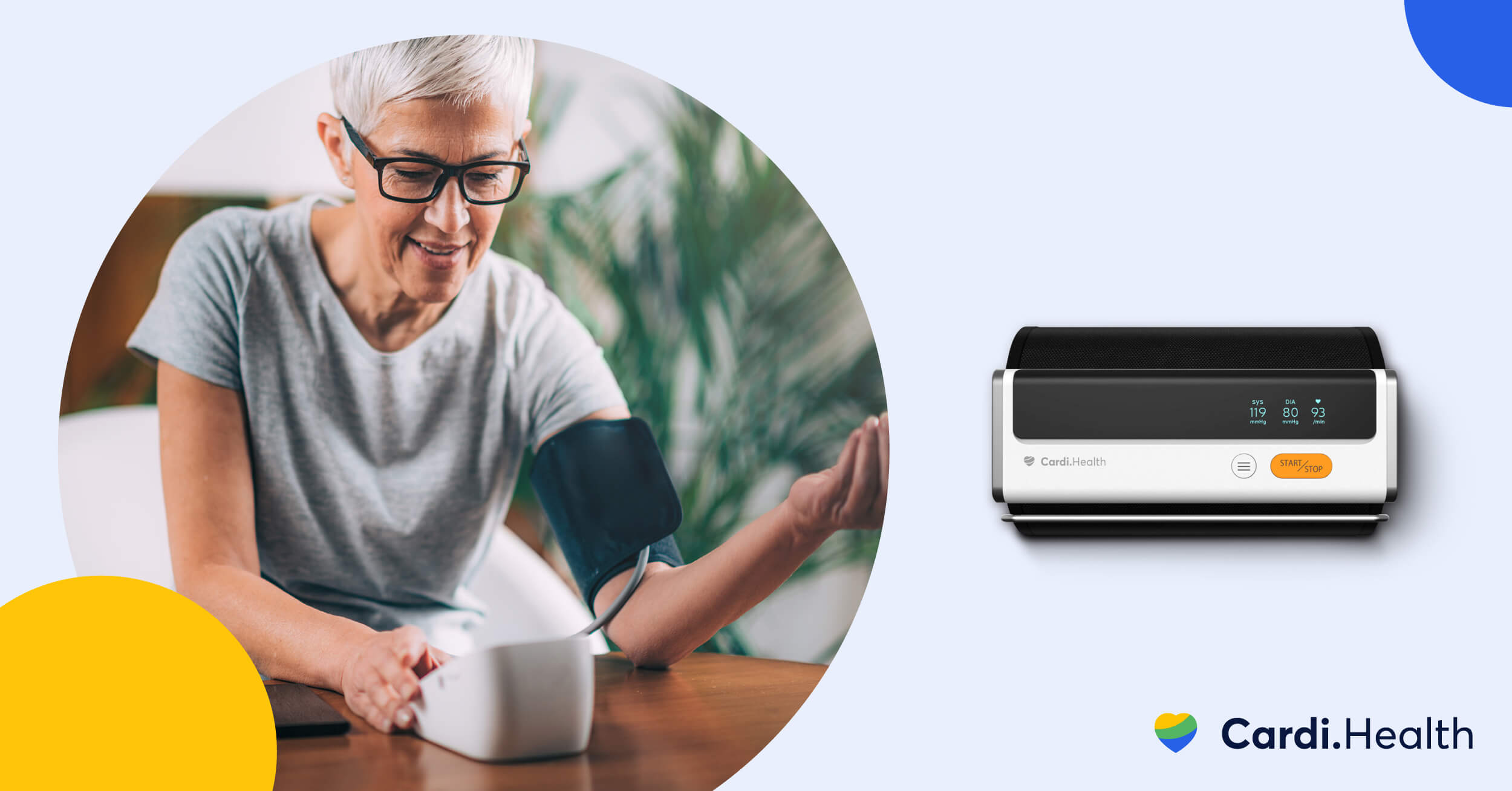Your Guide to Blood Pressure Measurement: How to Measure Blood Pressure Accurately
The blood pressure monitor has been around since the late 1800s and is the most important tool for tackling high blood pressure (hypertension).
There’s a lot to know if you have high blood pressure. For example, what types of home blood pressure monitors are there? How do you properly measure your blood pressure at home? What do these numbers mean?
This is the complete guide to blood pressure measurement, so let’s get into what you need to know.

Master your heart health now
Take part in our 60sec quiz and get a heart health plan tailored just for you.
Contents
Why Measuring Blood Pressure Is Important?

Blood pressure (BP) is how much force your heart pumps blood with. The higher the BP, the more forcefully your heart pumps with each beat.
Low blood pressure will prevent oxygen-rich blood from getting where it needs to be. High blood pressure can fatigue the heart and damage blood vessels in almost every major organ.
When you measure your blood pressure regularly, high blood pressure can be diagnosed quicker. Plus, normal blood pressure can reduce the risk of cardiovascular diseases.
For healthy adults over 40 without an increased risk of high blood pressure, checking your BP at least every five years tends to be enough. For those with an increased risk (such as family history), it is ideal to check yearly.
When diagnosed with high blood pressure, you should have your blood pressure measured as often as the doctor recommends.
Blood Pressure Measurement Techniques
BP monitors, or sphygmomanometers, have been around for well over a century. Since then, different forms of blood pressure monitors have been developed.
Manual sphygmomanometer
A manual sphygmomanometer requires manual inflation using a rubber bulb and manual reading of blood pressure measurements.
These can use mercury, which means the blood pressure is measured using a column of mercury, or aneroid, which means the readings are taken through a mechanical gauge.
Here are some of the reasons why manual monitors are appreciated:
- In the hands of professionals, blood pressure measurements are very accurate
- Usually cheaper than digital monitors
However, there are some downsides to using mercury or aneroid monitors that explain why they are being used less to measure your blood pressure at home:
- Requires more training than digital options
- Measurements are dependent on the person carrying out the blood pressure test
- Aneroid sphygmomanometers need to be calibrated occasionally
- Mercury monitors can pose an environmental hazard
Using a manual sphygmomanometer involves a stethoscope. Here’s how using this monitor for a blood pressure test works:
- The blood pressure cuff is worn on the upper arm.
- A stethoscope is fixed into the ears with the diaphragm tucked in place below the cuff.
- With the valve closed, squeeze the bulb to inflate the blood pressure cuff.
- Squeeze until the reading is about 30mmHg, more than your typical systolic blood pressure. You should hear nothing if done right.
- Open the valve a little so the reading begins to decrease slowly.
- Note the reading when you begin to hear a heartbeat-like sound. This indicates your systolic pressure.
- After this, note when the sound disappears. That is your diastolic blood pressure.
Start managing your heart health now!
Find out what works for you with this 60sec quiz.

Digital blood pressure monitors
A digital BP monitor automates most of the process for taking your blood pressure reading. You only need to wear the blood pressure cuff and press the start button. It’s the best at-home blood pressure monitor type because of its ease.
When looking for how to check blood pressure at home, these are the best. Many will read out your BP, store values, and even let you know if you have high blood pressure readings.
There are a lot of pros to these:
- Requires little training, so easy to use at home
- Comes with added features that can be helpful
- No space for human error
Of course, there are a few cons too:
- Using more advanced features may require a little tech savviness
- Tend to be more expensive than manual monitors
Ambulatory blood pressure monitoring
An ambulatory blood pressure device is a digital monitor that can read your BP continuously over 24 hours. The blood pressure cuff is worn as usual, with the device placed on the waist. It will provide several readings instead of just one.
This form of blood pressure screening is used mostly when a patient is suspected of having white coat syndrome – high blood pressure due to anxiety from the doctor’s office.
Here are some of the advantages of this type of home blood pressure monitoring:
- Can diagnose high blood pressure, even with white coat hypertension or masked hypertension
- Can pinpoint how daily events increase or decrease BP
The downsides of ambulatory blood pressure monitoring are:
- Wearing the cuff for 24 hours can cause upper arm discomfort
- They may not always be covered by insurance
Preparing for Blood Pressure Measurement

Before you take your blood pressure reading, you should properly prepare to ensure the most accurate reading. Here are a few tips to follow:
- Avoid stimulants like caffeine and nicotine. These temporarily increase blood pressure. Avoid energy drinks, coffee, soft drinks, and cigarettes 30 minutes before blood pressure is measured.
- Have a stable surface to rest your arm on.
- Find a comfortable, quiet place to sit with both feet flat on the ground. Wait there for 5 minutes before starting.
- Empty your bladder if it is full.
- Make sure your clothing allows you to expose your upper arm without any tightness.
Noise, stimulants, talking, a full bladder, a full stomach, crossed legs, and even low temperatures can all have a negative impact on your blood pressure.
Steps to Measure Blood Pressure
Home blood pressure readings are convenient and save you from needing to go to the clinic or pharmacy.
Checking your BP properly will facilitate getting your accurate blood pressure levels.
Doing a blood pressure test with a manual sphygmomanometer was described above. This section will focus more on digital monitors, which most people use.
If you’re looking for how to measure blood pressure with a wrist cuff or a blood pressure watch, it is essentially the same. The only difference is the location of the cuff.
1. Apply the blood pressure cuff correctly
With a digital monitor, the blood pressure cuff senses the blood pressure. This is why it has to be worn correctly. Whether manual or digital, the bottom edge of the cuff should be an inch above the bend of the elbow.
With a digital cuff, the sensor that detects blood pulsing through a major artery (usually the brachial artery) should usually lie on the front and inside of the arm. Check the cuff labeling to be sure.
Also, make sure the cuff isn’t too tight. You should be able to fit two fingers under it.
2. Position the arm and body
Correct positioning allows for proper blood flow through the body and prevents you from affecting your blood pressure with your posture.
The forearm of the arm being measured should be on a surface at chest height. Your palm should be open and facing up.
Sit with your back well rested in a chair, with both feet flat on the ground.
3. Inflating and deflating the cuff
With a manual monitor, inflation is done by locking the valve and squeezing the bulb, and deflation is accomplished by opening the valve.
With a digital monitor, just press the “Start” button. It will automatically inflate, read your BP, and then deflate slowly once done.
Start managing your heart health now!
Find out what works for you with this 60sec quiz.

Interpreting Blood Pressure Readings
Understanding blood pressure readings is important if you monitor your blood pressure at home. For example, what counts as a high blood pressure reading? The table below, from the American Heart Association, will show you how blood pressure is categorized.
| Blood pressure category: | Systolic BP (mmHg): | Diastolic BP (mmHg): |
| Normal range | 120 | 80 |
| Prehypertension | 120–129 | 80 |
| Hypertension stage 1 | 130–139 | 80–89 |
| Hypertension stage 2 | 140 | 90 |
| Hypertensive crisis | 180 | 120 |
Prehypertension is usually a sign that hypertension will develop if nothing is done about risk factors.
In hypertension stage 1, lifestyle changes are typically used for management, but blood pressure medication may sometimes be used for people with a major risk factor for cardiovascular disease like a heart attack. In hypertension stage 2, medication is almost always prescribed.
Finally, a hypertensive crisis is a medical emergency. Symptoms like shortness of breath, weakness, blurred vision, and pain in the chest might be felt. You should seek medical help immediately.
Understanding systolic and diastolic numbers
When it comes to blood pressure numbers, the first is your systolic pressure, and the second is the diastolic pressure.
Systolic pressure is the force of your blood flow against the walls of the blood vessels when the heart beats. Diastolic pressure is the force between each beat when the heart is relaxed. Therefore, it is always the lower number.
Both are important in understanding your heart health. The systolic number lets you know how blood is fed to the whole body.
However, the diastolic number tells you how much blood is being pumped into the heart muscle. This is because the coronary arteries that supply blood to the heart only get fed when the heart is relaxed.
Tips for Maintaining Healthy Blood Pressure

Keeping your BP controlled can reduce the risk of cardiovascular disease and promote a healthier life. Here are some tips to help you achieve that.
Lifestyle modifications
Healthcare professionals typically recommend lifestyle changes to manage high blood pressure. This is for a good reason, as they can be effective in managing these conditions.
- A balanced diet, especially one low in unhealthy fats, sodium, and red meat, can combat high blood pressure. More healthy fats and fiber can help too.
- Blood pressure falls with increased physical activity, and it can bring about weight loss too, which also helps.
- Proper stress management techniques can help reduce stress, which not only reduces blood pressure but can help mentally too.
Keep a blood pressure log
Having your blood pressure checked regularly and keeping a blood pressure diary can be very helpful for your health.
A blood pressure log, such as the one in the Cardi Health app, can help you check and understand trends in your self-measured blood pressure values over time. For instance, why your blood pressure falls or rises over the course of a week or a month.
Regular checkups with a healthcare provider
Of course, it is always important to visit your healthcare professional. They can figure out whether your management needs any adjustments or if your BP is well controlled.
They can also assess for heart disease and other complications of hypertension.
Start managing your heart health now!
Find out what works for you with this 60sec quiz.

FAQ
Why is it crucial to measure blood pressure regularly?
Regular blood pressure measurements can diagnose high blood pressure earlier and help reduce the risk of cardiovascular diseases.
What is the difference between manual and digital blood pressure monitors?
Manual sphygmomanometers require manual inflation and reading, while digital monitors automate the measurement process, making them easier for at-home use.
How does an ambulatory blood pressure device work?
It’s a digital monitor that reads your BP continuously over 24 hours, useful for diagnosing conditions like white coat syndrome.
What precautions should one take before measuring their blood pressure?
Avoid stimulants, ensure a stable surface for the arm, sit in a quiet place with feet flat on the ground, and empty the bladder if full.
Blood Pressure Measurement: Key Takeaways
The blood pressure test is very important for people with hypertension or people with normal blood pressure and risk factors for heart disease.
It is essential to check your blood pressure regularly. Having an accurate measurement of your BP can be key to living a healthier life.
Related articles
Best Foods to Lower Cholesterol
Does Caffeine Raise Blood Pressure?
Does Drinking Water Lower Blood Pressure?
Causes of High Blood Pressure at Night
10 DASH Diet Breakfasts for a Healthy Start
Heart-Healthy Diet Guide
What Should an 85-Year-Old Blood Pressure Be?
What is Normal Blood Pressure for a 70-Year-Old?
How to Read Blood Pressure: A Comprehensive Guide
Manage your heart health now
Find out what works best for you with this 60sec quiz and get your personalized heart health plan.

